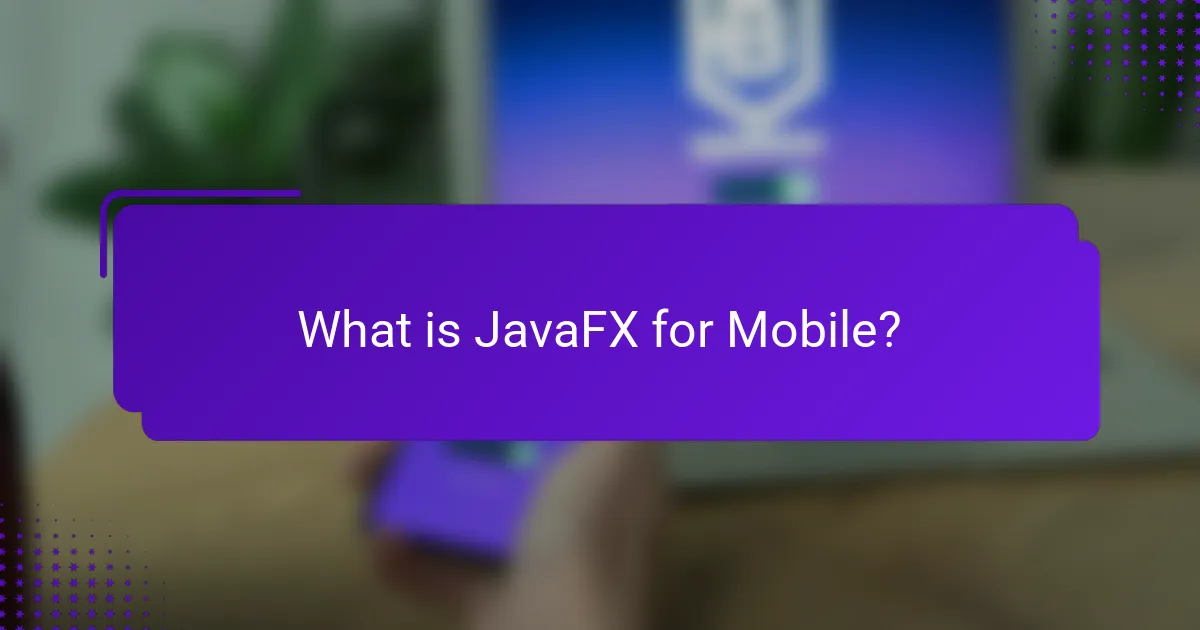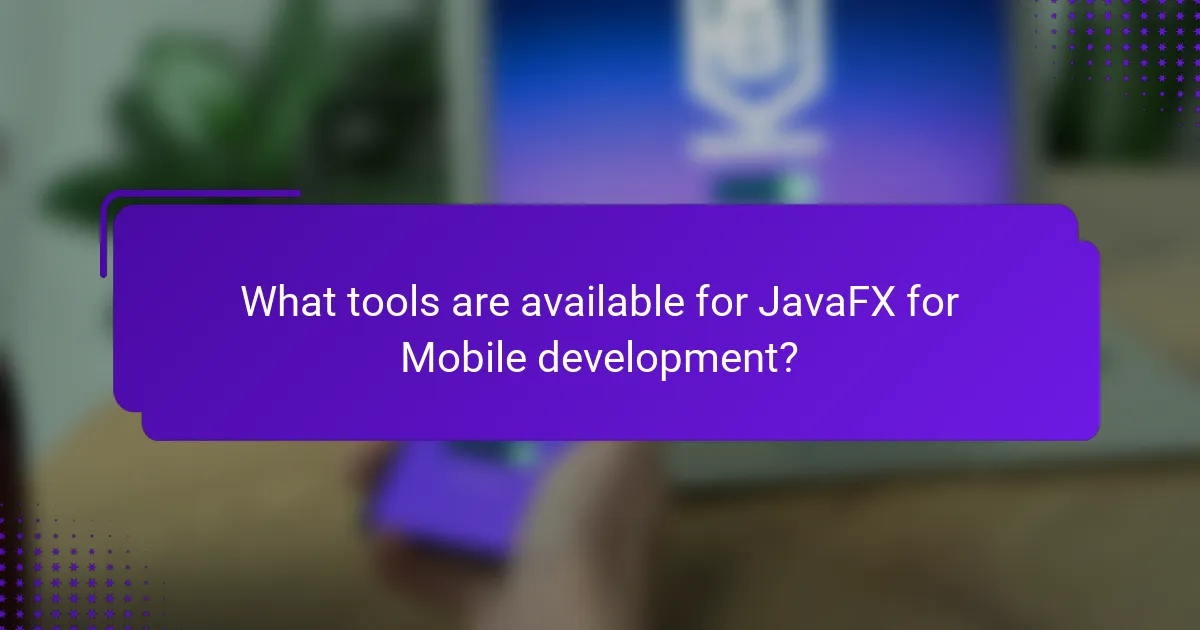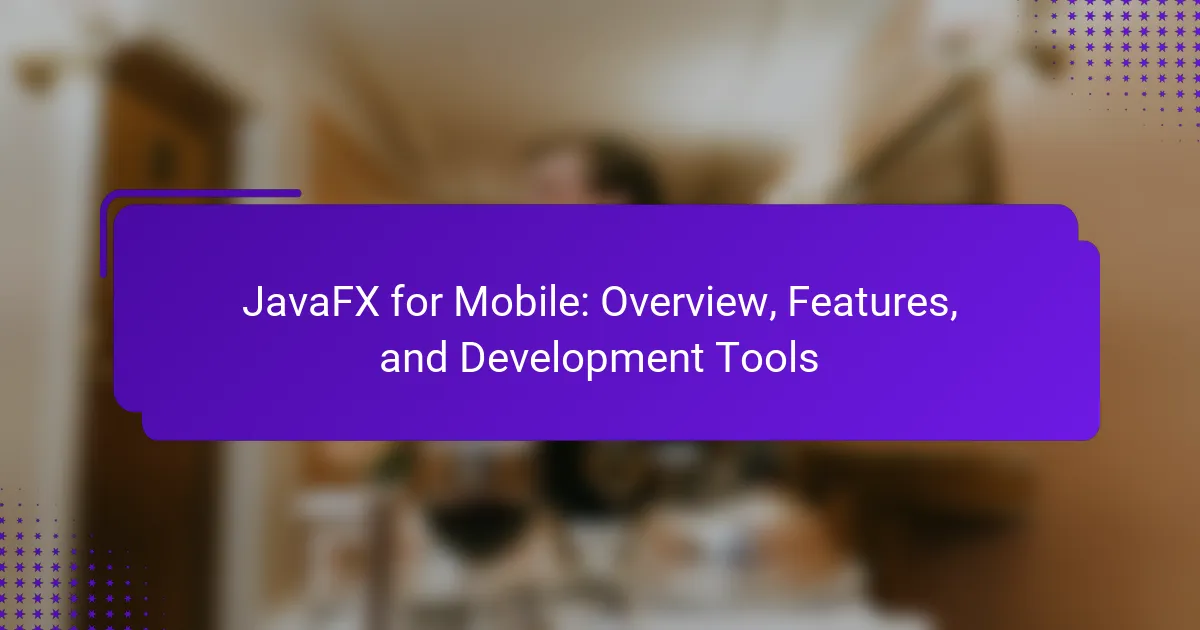JavaFX for Mobile is a framework that enables the development of rich client applications for mobile devices, supporting platforms such as Android and iOS. This framework utilizes Java’s capabilities to deliver a robust user interface and multimedia features, while also integrating seamlessly with existing Java libraries and tools. Key functionalities include hardware acceleration, touch input support, and a comprehensive set of APIs for graphics and media. Tools like Gluon Mobile and Scene Builder enhance the development experience, allowing for efficient cross-platform application creation. JavaFX for Mobile stands out for its performance, versatility, and strong community support, making it an ideal choice for mobile application development.

What is JavaFX for Mobile?
JavaFX for Mobile is a framework designed for building rich client applications on mobile devices. It allows developers to create applications that run on various mobile platforms, including Android and iOS. JavaFX for Mobile leverages Java’s capabilities to provide a rich user interface and multimedia support. The framework integrates with existing Java libraries and tools, enhancing development efficiency. It supports features like hardware acceleration and touch input, which are essential for mobile applications. JavaFX for Mobile is part of the broader JavaFX ecosystem, which is known for its modern UI components and graphics capabilities. This framework aims to provide a consistent development experience across different devices.
How does JavaFX for Mobile function?
JavaFX for Mobile functions by providing a framework for building rich client applications on mobile devices. It allows developers to create applications using Java and FXML, which is an XML-based markup language. JavaFX utilizes a hardware-accelerated graphics pipeline to render user interfaces efficiently. The framework supports touch events, gestures, and other mobile-specific interactions. It enables the use of CSS for styling applications, ensuring a consistent look across platforms. JavaFX applications can be packaged as native applications for Android and iOS. This capability enhances performance and user experience on mobile devices. JavaFX for Mobile integrates with existing Java libraries, allowing developers to leverage a wide range of functionalities.
What are the core components of JavaFX for Mobile?
The core components of JavaFX for Mobile are the JavaFX runtime, Scene Graph, and UI Controls. The JavaFX runtime provides the environment for executing JavaFX applications on mobile devices. The Scene Graph is a hierarchical structure that represents the user interface and its elements. UI Controls include various components like buttons, labels, and text fields that allow user interaction. Together, these components facilitate the development of rich mobile applications. JavaFX for Mobile supports touch events, enabling a responsive user experience on mobile platforms. These features ensure that developers can create visually appealing and functional applications for mobile users.
How do these components interact within mobile applications?
In mobile applications, components such as user interface elements, event handlers, and application logic interact seamlessly. User interface elements display data and receive user input. Event handlers respond to user actions like taps or swipes. Application logic processes data and manages the state of the application.
These components communicate through a structured framework. For instance, when a user interacts with a button, the event handler captures the action. It then triggers the application logic to execute a specific function. This may involve updating the user interface with new data.
JavaFX facilitates this interaction with its built-in features. It provides a scene graph to manage UI components efficiently. The framework also supports binding, allowing dynamic updates between UI elements and application logic. This ensures a responsive user experience.
Overall, the integration of these components is crucial for mobile application functionality and user engagement.
What are the key features of JavaFX for Mobile?
JavaFX for Mobile provides a rich set of features tailored for mobile application development. It supports hardware-accelerated graphics, enabling smooth animations and transitions. The framework includes a flexible layout system that adapts to different screen sizes and orientations. JavaFX for Mobile also offers a comprehensive UI controls library, allowing developers to create responsive user interfaces. It supports touch events, enhancing user interaction on mobile devices. Additionally, JavaFX integrates well with existing Java libraries, facilitating code reuse. The framework is designed to work across multiple platforms, ensuring cross-platform compatibility. Finally, JavaFX for Mobile leverages the Java ecosystem, providing access to a vast array of tools and resources for developers.
How does JavaFX for Mobile enhance user experience?
JavaFX for Mobile enhances user experience by providing a rich, interactive interface for mobile applications. It supports modern UI components and effects, improving visual appeal. The framework allows for responsive design, adapting to various screen sizes and orientations. Additionally, it integrates seamlessly with touch gestures, enhancing navigation and interaction. JavaFX for Mobile also enables high-performance graphics rendering, which improves application responsiveness. The use of FXML for UI design simplifies the development process, allowing for easier updates and maintenance. Overall, these features contribute to a more engaging and user-friendly mobile experience.
What unique capabilities does JavaFX for Mobile offer for developers?
JavaFX for Mobile offers unique capabilities such as cross-platform compatibility, allowing developers to create applications that run on multiple mobile operating systems. It supports rich user interfaces with advanced graphics and animations, enhancing the visual experience. Developers can leverage FXML for UI design, simplifying the separation of design and logic. The framework provides access to hardware features like touch gestures and sensors, enabling more interactive applications. JavaFX for Mobile also integrates seamlessly with Java libraries, allowing the reuse of existing code. Furthermore, it supports responsive layouts, ensuring applications adapt to various screen sizes. These capabilities make JavaFX for Mobile a powerful tool for mobile application development.

Why choose JavaFX for Mobile development?
JavaFX is a strong choice for mobile development due to its rich set of features and cross-platform capabilities. It allows developers to create visually appealing interfaces using FXML and CSS. JavaFX supports hardware acceleration, enhancing performance on mobile devices. The framework provides a comprehensive set of APIs for graphics, media, and user interface controls. Additionally, JavaFX applications can run on various platforms, including Android and iOS, with minimal code changes. This flexibility streamlines the development process. The community support for JavaFX is robust, offering resources and libraries to aid development. Overall, JavaFX combines performance, versatility, and a rich user experience, making it suitable for mobile applications.
What advantages does JavaFX for Mobile provide over other frameworks?
JavaFX for Mobile offers several advantages over other frameworks. It provides a rich set of UI controls and graphics capabilities. This allows developers to create visually appealing applications with ease. JavaFX also supports CSS for styling, which enhances customization options. Its integration with Java enables code reuse across platforms, reducing development time. Moreover, JavaFX for Mobile supports hardware acceleration, improving performance on mobile devices. The framework is designed for cross-platform compatibility, allowing applications to run on various operating systems seamlessly. Additionally, JavaFX has a strong community and extensive documentation, facilitating easier troubleshooting and support. Overall, these features make JavaFX for Mobile a compelling choice for mobile application development.
How does JavaFX for Mobile improve development efficiency?
JavaFX for Mobile improves development efficiency by providing a unified framework for cross-platform application development. It allows developers to write code once and deploy it on multiple mobile platforms, reducing the time spent on platform-specific adjustments. The framework supports a rich set of UI controls and layouts, which accelerates the design process. Additionally, JavaFX integrates seamlessly with existing Java libraries, enabling code reuse and minimizing development effort. Its Scene Builder tool simplifies UI design through a drag-and-drop interface, further enhancing productivity. By leveraging Java’s performance and scalability, JavaFX for Mobile ensures that applications run efficiently across devices.
What are the long-term benefits of using JavaFX for Mobile?
JavaFX for Mobile offers several long-term benefits. It enables cross-platform development, allowing developers to create applications for multiple devices using a single codebase. This reduces development time and costs significantly. JavaFX also provides a rich set of user interface controls and graphics capabilities, enhancing the visual appeal of mobile applications. The framework is built on Java, ensuring access to a vast ecosystem of libraries and tools. Additionally, JavaFX supports modern development practices, such as responsive design, which is crucial for today’s diverse mobile environment. Its active community contributes to ongoing updates and improvements, ensuring longevity and support for developers. Overall, JavaFX for Mobile is a robust solution for future-proof mobile application development.
What challenges might developers face with JavaFX for Mobile?
Developers may face several challenges with JavaFX for Mobile. One significant challenge is limited platform support. JavaFX for Mobile is not as widely adopted as other frameworks, leading to compatibility issues. Performance optimization is another challenge. Mobile devices often have less processing power compared to desktops, which can affect application responsiveness.
Additionally, developers may encounter difficulties with the user interface. Designing touch-friendly interfaces can be complex in JavaFX. There are also challenges related to deployment. Packaging applications for various mobile platforms requires extra effort.
Another issue is the lack of comprehensive documentation. Developers may struggle to find resources and community support. Finally, integration with native mobile features can be cumbersome. Accessing device-specific functionalities often requires additional workarounds.
How can developers overcome common issues in JavaFX for Mobile?
Developers can overcome common issues in JavaFX for Mobile by optimizing performance and ensuring compatibility. They should use lightweight UI components to reduce load times. Profiling tools can help identify performance bottlenecks. Developers must also test on various devices to ensure compatibility. Utilizing the latest JavaFX updates can address many bugs. Documentation from Oracle provides solutions for known issues. Community forums often share effective workarounds. Following these strategies can significantly enhance the development experience in JavaFX for Mobile.
What resources are available for troubleshooting JavaFX for Mobile?
Official documentation from Oracle provides comprehensive troubleshooting guidelines for JavaFX on mobile platforms. The JavaFX GitHub repository contains issue tracking and community support. Online forums like Stack Overflow feature discussions and solutions from developers facing similar issues. Additionally, various tutorials and blog posts offer step-by-step troubleshooting tips. The JavaFX community on Reddit provides insights and shared experiences from other users. These resources collectively assist in resolving common challenges encountered in JavaFX mobile development.

What tools are available for JavaFX for Mobile development?
JavaFX for Mobile development has several tools available. These tools include Gluon Mobile, which provides a framework for building mobile applications with JavaFX. Gluon provides a seamless integration with JavaFX, allowing developers to create cross-platform applications. Another tool is Scene Builder, which offers a visual layout editor for designing user interfaces. Developers can also utilize JavaFX ports for iOS and Android, enabling native performance on mobile devices. Additionally, Maven can be used for dependency management in JavaFX projects. These tools collectively enhance the JavaFX mobile development experience, making it more efficient and user-friendly.
What IDEs support JavaFX for Mobile development?
IntelliJ IDEA, Eclipse, and NetBeans support JavaFX for mobile development. IntelliJ IDEA offers a robust environment with plugins for JavaFX. Eclipse provides the e(fx)clipse plugin, enhancing JavaFX support. NetBeans has built-in support for JavaFX projects. These IDEs facilitate the development process through features like code completion and debugging tools. They are widely used in the Java community for mobile application development.
How do these IDEs facilitate the development process?
IDEs facilitate the development process by providing integrated tools that streamline coding and debugging. They offer features like code completion, which speeds up writing by suggesting relevant code snippets. IDEs also include debugging tools that allow developers to identify and fix errors efficiently. Built-in version control systems help manage code changes and collaboration among team members. Additionally, they provide visual design tools for creating user interfaces, enhancing productivity. Many IDEs support various libraries and frameworks, simplifying the integration of external functionalities. According to a study by Stack Overflow, 70% of developers report increased productivity when using IDEs compared to text editors.
What plugins enhance JavaFX for Mobile development in these IDEs?
JavaFX for Mobile development can be enhanced by plugins in various IDEs. In IntelliJ IDEA, the JavaFX Plugin provides support for building JavaFX applications. Eclipse offers the e(fx)clipse plugin, which integrates JavaFX into the Eclipse environment. NetBeans has built-in support for JavaFX, allowing developers to easily create mobile applications. These plugins facilitate UI design, provide code assistance, and streamline the development process.
What libraries and frameworks complement JavaFX for Mobile?
Libraries and frameworks that complement JavaFX for Mobile include Gluon and JFoenix. Gluon provides tools for developing cross-platform applications using JavaFX. It simplifies mobile development by offering a cloud service and a set of libraries designed for mobile platforms. JFoenix is a library that offers Material Design components for JavaFX applications. These components enhance the user interface of JavaFX apps, making them more visually appealing. Both libraries are widely used in the JavaFX community, supporting mobile development effectively.
How can these libraries improve the functionality of JavaFX applications?
Libraries can enhance the functionality of JavaFX applications by providing additional components and tools. These libraries often include pre-built UI controls, advanced graphics capabilities, and integration with other technologies. For instance, libraries like JFoenix offer Material Design components that improve visual aesthetics. Other libraries, such as ControlsFX, provide enhanced controls like notification bars and spinners. These enhancements streamline development and improve user experience. Additionally, libraries can offer performance optimizations, making applications more responsive. They may also include support for animations and effects, enriching the overall interactivity of JavaFX applications.
What are the best practices for integrating additional libraries with JavaFX for Mobile?
To integrate additional libraries with JavaFX for Mobile effectively, follow these best practices. First, ensure compatibility with JavaFX’s mobile architecture. Use libraries that support JavaFX’s modularity and are optimized for mobile performance. Next, manage dependencies carefully to avoid conflicts. Utilize a build tool like Maven or Gradle to handle library versions and transitive dependencies.
Additionally, leverage JavaFX’s features for UI components when integrating libraries. This ensures a consistent user experience across different devices. It’s also crucial to test the application on various mobile platforms. This helps identify any issues stemming from the integrated libraries. Lastly, consult documentation and community forums specific to JavaFX for Mobile. This provides insights into common integration challenges and solutions.
What are the best practices for developing with JavaFX for Mobile?
Use responsive design principles when developing with JavaFX for Mobile. This ensures that your application adapts to various screen sizes and orientations. Leverage touch-friendly UI components to enhance user interaction on mobile devices. Optimize performance by minimizing resource usage and employing lazy loading techniques for images and data. Test your application on multiple devices and emulators to identify platform-specific issues. Utilize JavaFX’s built-in CSS capabilities to create visually appealing interfaces while maintaining performance. Follow the guidelines provided by the JavaFX community for best practices and updates. Regularly update your JavaFX libraries to benefit from improvements and security patches.
How can developers optimize performance in JavaFX for Mobile applications?
Developers can optimize performance in JavaFX for mobile applications by using efficient rendering techniques. They should minimize the use of heavy graphics and complex animations. Reducing the number of nodes in the scene graph can enhance performance. Utilizing hardware acceleration helps in rendering graphics more efficiently. Developers should also prefer lightweight controls to decrease memory usage. Profiling the application with tools like VisualVM can identify performance bottlenecks. Implementing lazy loading for resources can improve startup time. Finally, optimizing event handling by reducing listener complexity can lead to smoother interactions.
What design principles should be followed when using JavaFX for Mobile?
When using JavaFX for Mobile, several design principles should be followed. First, prioritize responsive design to ensure applications adapt to various screen sizes. Second, maintain simplicity in user interfaces for better usability. Third, optimize performance by minimizing resource usage. Fourth, utilize touch-friendly controls to enhance user interaction. Fifth, ensure visual consistency across different devices for a cohesive experience. These principles enhance user satisfaction and application effectiveness in mobile environments.
JavaFX for Mobile is a framework designed for creating rich client applications on mobile devices, supporting platforms such as Android and iOS. It leverages Java’s capabilities to provide advanced user interfaces, hardware acceleration, and multimedia support, facilitating efficient mobile application development. Key components include the JavaFX runtime, Scene Graph, and UI Controls, which enable seamless interaction and responsiveness. The framework also offers features like cross-platform compatibility, a comprehensive UI controls library, and integration with existing Java libraries, enhancing development efficiency and user experience. Additionally, tools and IDEs such as Gluon Mobile, Scene Builder, and IntelliJ IDEA support the development process, while best practices and optimization techniques ensure high performance in mobile applications.
